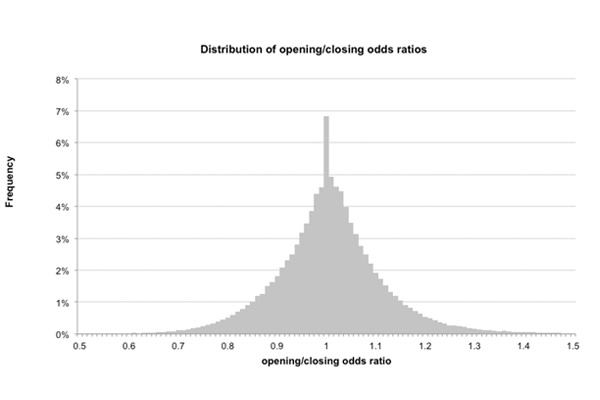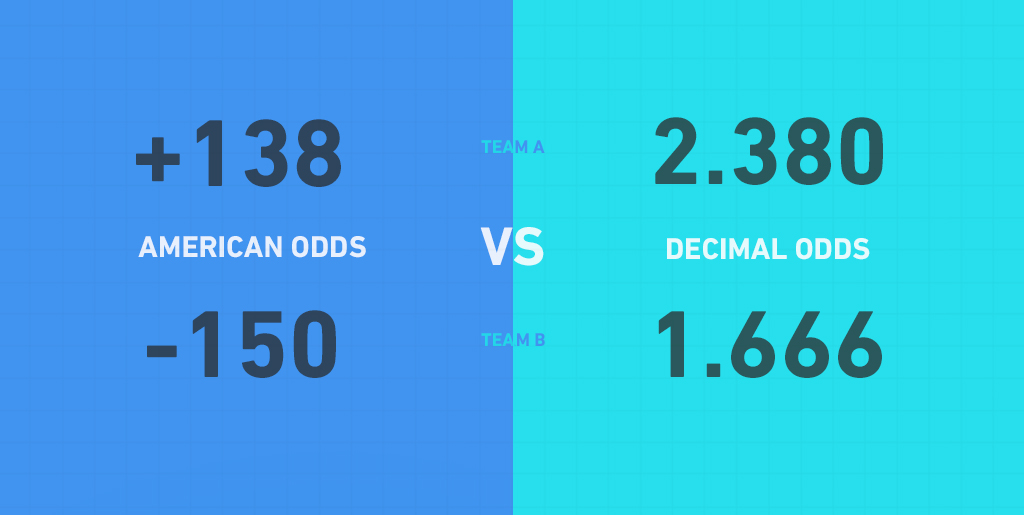What Does Betting Odds Ratio Mean
What does +200 mean? +200 is a specific set of odds attached to a given sports event. These are in the form of ‘American’ odds’. The +200 represents the amount a bettor would win if they had wagered $100. A profit of $200 and a total payout of $300. Other types of odds are Decimal and Fractional. What Types of Odds Do Sportsbooks Use? Odds On & Odds Against – Two of the key terms that you’ll hear when it comes to betting odds are ‘odds on’ and ‘odds against’. These terms refer to whether a price is greater or lower than evens. Any price above evens is known as odds against, while anything below evens is odds on.
- This ratio is constant: it does not change according to the value of the other Xs because they cancel out in the calculation. Be careful about language: This is called the odds ratio; it is called that because it is the ratio of two odds. Some people call the odds the odds ratio because the odds itself is a ratio. That is fine English, but this.
- We use the closet fraction that is used in betting markets. For example, the exact mathematical equivalent of decimal odds 30 is fractional odds 29/1. However 29/1 is not used in betting markets, instead 30/1 is used, so that is what appears in this converter.
- If the odd is negative (-) it means that outcome is more likely to happen and placing a bet on that outcome would payout less than the amount you wagered, while a positive (+) odd shows that the outcome is less likely to happen and it would pay out more than the amount you wagered.
Welcome to the Sports Betting Odds section of The Sports Geek. If you are new to sports betting and don’t understand how to read betting odds (+150, -110, +2200, etc) we will lay it all out for you and help you learn how the betting odds work.
Betting Site | Bonus | Bet Now | |
|---|---|---|---|
| 1 | up to €30 Free Bet | Go to Site | |
| 2 | 22Bet | 100% up to €122 | Go to Site |
| 3 | 100% up to €200 | Go to Site | |
| 4 | 10Bet | 100% up to €50 | Go to Site |
| 5 | 100% up to €50 | Go to Site |
Sports Betting Odds Explained
Many people don’t know how to read or calculate sports betting odds, so below we have done our best on explaining how betting odds work. The most common type of sports betting odds used in North America are the American style odds which we explain below.
American Style Sports Betting Odds
Most online sportsbooks will list their odds in what is called “American Odds”. There are a couple different versions of sports betting odds, but these American Odds are the most common odds used. Reading and understanding sports betting odds can bet a little confusing to beginners, so we have provided an example below using two NFL football teams:
American Odds
- Matchup Odds
- New England Patriots +120
- Pittsburgh Steelers -140
The number shown in the bracket represents the odds. The American Odds have two components to them, the first being the positive or negative sign, and the second being the number that follows the sign.

The sign in front of the number indicates whether placing a wager on that outcome will pay out more money then you have wagered or less money then you have wagered. If the odd is negative (-) it means that outcome is more likely to happen and placing a bet on that outcome would payout less than the amount you wagered, while a positive (+) odd shows that the outcome is less likely to happen and it would pay out more than the amount you wagered.

The next step is figuring out exactly how much the bet pays out, which is where the numbers in the odds come into play.
A listed odd with a – sign in front of it, such as the -140 in our example above, shows us how much money you would need to wager in order to win $100. So using the -140, this would show us that you would need to bet $140 in order to win $100 in profits. You can easily substitute the $100 bet for a $10 bet by moving the decimal place over one spot, showing us that you would need to wager $14 in order to win $10 in profits.
Examples:
A listed odd with a + sign in front of it, such as the +120 in our example above, shows us how much money you would win on a $100 bet. Using the +120 odds, it shows us that a $100 bet on that outcome would pay out $120 in profits. Again this can easily be converted into smaller or larger size bets. A $10 bet on +120 odds would pay out $12 in profits.
Examples:
Below is an example of NFL betting odds taken from an online betting site.
In this example you can see Los Angeles is listed at +130 ($100 bet pays $130 plus of course your original wager back) and New England is listed at -150 ($150 bet pays $100).
The great thing about betting online is that the online sportsbooks will do the calculations for you before you place your bet. You can click on the outcome or team you would like to bet on, and then input the amount you wish to wager and it will show you your potential pay out before you confirm your bet.
Ready To Start Betting?MyBookie and BetUS are my two favorite sportsbooks and make betting very easy. You will also get a Free Money Bonus at each sportsbook if you follow either link above.
Decimal Style Sports Betting Odds
Decimal style odds are used mostly in Europe, and are pretty easy to understand. To calculate the decimal style odds all you will need to do is simply multiply the amount you wish to wager by the decimal odds shown and you will get your payout. For example it may look something like this:
If you wanted to place a $10 wager on the USA at 2.40 you would simply need to multiply your $10 wager by the 2.40 odds (10 x 2.40) to find out that the payout is $24. It is important to realize that with decimal style odds it includes the amount you wagered, so to find out profits you would need to subtract your wager ($24 – $10) to find out your potential payout is $14 in profits.
If you wanted to place a $10 wager on Brazil you would again just multiply $10 x 1.55 to find out that you would win $15.50 total or $5.50 in profits.
Decimal style betting odds are very simple to understand, but you won’t see them displayed in many North American sportsbooks. With that said, most online betting sites will allow you to chose the style of betting odds you want displayed, with American odds set as the default.
In statistics, probability refers to the chances of some event happening. It is calculated as:
PROBABILITY:
P(event) = (# desirable outcomes) / (# possible outcomes)
For example, suppose we have four red balls and one green ball in a bag. If you close your eyes and randomly select a ball, the probability that you choose a green ball is calculated as:
P(green) = 1 / 5 = 0.2.
The odds of some event happening can be calculated as:
ODDS:
Odds(event) = P(event happens) / 1-P(event happens)
For example, the odds of picking a green ball are (0.2) / 1-(0.2) = 0.2 / 0.8 = 0.25.
The odds ratio is the ratio of two odds.
ODDS RATIO:
Odds Ratio = Odds of Event A / Odds of Event B

For example, we could calculate the odds ratio between picking a red ball and a green ball.
The probability of picking a red ball is 4/5 = 0.8.
The odds of picking a red ball are (0.8) / 1-(0.8) = 0.8 / 0.2 = 4.
The odds ratio for picking a red ball compared to a green ball is calculated as:
Odds(red) / Odds(green) = 4 / 0.25 = 16.

Thus, the odds of picking a red ball are 16 times larger than the odds of picking a green ball.
When Are Odds Ratios Used in the Real World?
In the real world, odds ratios are used in a variety of settings in which researchers want to compare the odds of two events occurring. Here are a couple examples.
Example #1: Interpreting Odds Ratios
Researchers want to know if a new treatment improves the odds of a patient experiencing a positive health outcome compared to an existing treatment. The following table shows the number of patients who experienced a positive or negative health outcome, based on treatment.
The odds of a patient experiencing a positive outcome under the new treatment can be calculated as:
Odds = P(positive) / 1 – P(positive) = (50/90) / 1-(50/90) = (50/90) / (40/90) = 1.25
The odds of a patient experiencing a positive outcome under the existing treatment can be calculated as:
Odds = P(positive) / 1 – P(positive) = (42/90) / 1-(42/90) = (42/90) / (48/90) = 0.875
Thus, the odds ratio for experiencing a positive outcome under the new treatment compared to the existing treatment can be calculated as:
Odds Ratio = 1.25 / 0.875 = 1.428.
We would interpret this to mean that the odds that a patient experiences a positive outcome using the new treatment are 1.428timestheodds that a patient experiences a positive outcome using the existing treatment. In other words, the odds of experiencing a positive outcome are increased by 42.8% under the new treatment.
Example #2: Interpreting Odds Ratios
Marketers want to know if one advertisement causes customers to buy a certain item more often than another advertisement so they show each advertisement to 100 individuals. The following table shows the number of people who bought the item, based on which advertisement they saw:
The odds of an individual buying the item after seeing the first advertisement can be calculated as:
What Does Sports Odds Mean
Odds = P(bought) / 1 – P(bought) = (73/100) / 1-(73/100) = (73/100) / (27/100) = 2.704
The odds of an individual buying the item after seeing the second advertisement can be calculated as:
Odds = P(bought) / 1 – P(bought) = (65/100) / 1-(65/10) = (65/100) / (35/100) = 1.857
Thus, the odds ratio for a customer buying the item after seeing the first advertisement compared to buying after seeing the second advertisement can be calculated as:
Odds Ratio = 2.704 / 1.857 = 1.456.
What Does +500 Odds Mean
We would interpret this to mean that the odds that an individual buys the item after seeing the first advertisement are 1.456timestheodds that an individual buys the item after seeing the second advertisement. In other words, the odds of buying the item are increased by 45.6% using the first advertisement.



